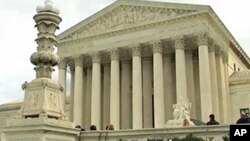The U.S. Supreme Court started a new session this week, marking the 75th anniversary of the high court in Washington. The court is made up of nine justices, each appointed by a president, then confirmed by the U.S. Senate. Legal experts say the high court has evolved over the years even as it continues to take up cases that present complex constitutional issues.
Located in the heart of Washington is the most powerful court of justice in the United States. In fact, Law Professor Jeffrey Rosen at The George Washington University points out, it is unique among the constitutional courts of the world.
"It has great power and the most important power is the ability to strike down laws passed by Congress and State Legislatures if the justices feel they violate the U.S. Constitution," said Professor Rosen.
First time in history
This year, for the first time in the history of the United States, three of the nine justices on the Supreme Court are women.
In the past five years, there have been four new justices appointed to the court.
Affect personal dynamics
Professor Rosen says that may affect the personal dynamics on the court, but probably not its recent trend toward becoming more conservative.
What's new, he says, is that the court may now be perceived as being partisan.
"This is the first time that all the liberals are democratic appointees and all the five conservatives are Republican appointees," Rosen added. "So there is a danger that the court will be perceived as political. I think the justices themselves would reject that claim. They would feel that despite their clear ideological and philosophical differences, no one would ever cast a vote purely for political reasons."
Decisions without political pressure
The Court is supposed to be insulated from partisanship. The Constitution gives Supreme Court justices lifetime appointments so they can make decisions without political pressure. But the Supreme Court has still at times been accused of playing politics. In 2000, there was no clear winner in the Presidential election between Al Gore and George W. Bush. In a five to four vote, the court sided with Bush – a decision that put him in the White House.
"After the Bush Vs Gore decision public confidence in the court among democrats plummeted to something like 30 or 40 percent but it soared among Republicans to 70 or 80 percent," he said. "Nevertheless a year later the numbers were pretty well equal as they were before the decision."
The Supreme Court is constantly tested by high-profile cases. Many of the most contentious involve the free speech provisions of the U.S. Constitution's First Amendment.
Right to protest
One such case this year questions whether members of a church have a right to protest with offensive signs at a U.S. Marine's funeral.
Charles Haynes heads the Religious Freedom Education Project at the Newseum. He says "If we allow the government to decide what's offensive speech, and what isn't offensive then I think it limits the rights of all of us to express what we believe."
Legal experts also expect cases involving such social issues as health care reform and same-sex marriage to end up in the Supreme Court.
Judges' ideological beliefs
Jeff Rosen says the judges' ideological beliefs are most likely the dominant factor when they consider a case. But he says the Court still occupies a position of public confidence and legitimacy.
"Although its decision are often hotly debated, people criticize them intensely. There still is a feel that the court ultimately is deciding things based on philosophy rather than pure partisanship and that its decisions have to be obeyed even when you disagree with them"
Rosen says one reason the court is respected by Americans – even when they disagree with its decisions - is that when the justices rule on an issue, they also have to explain why.






